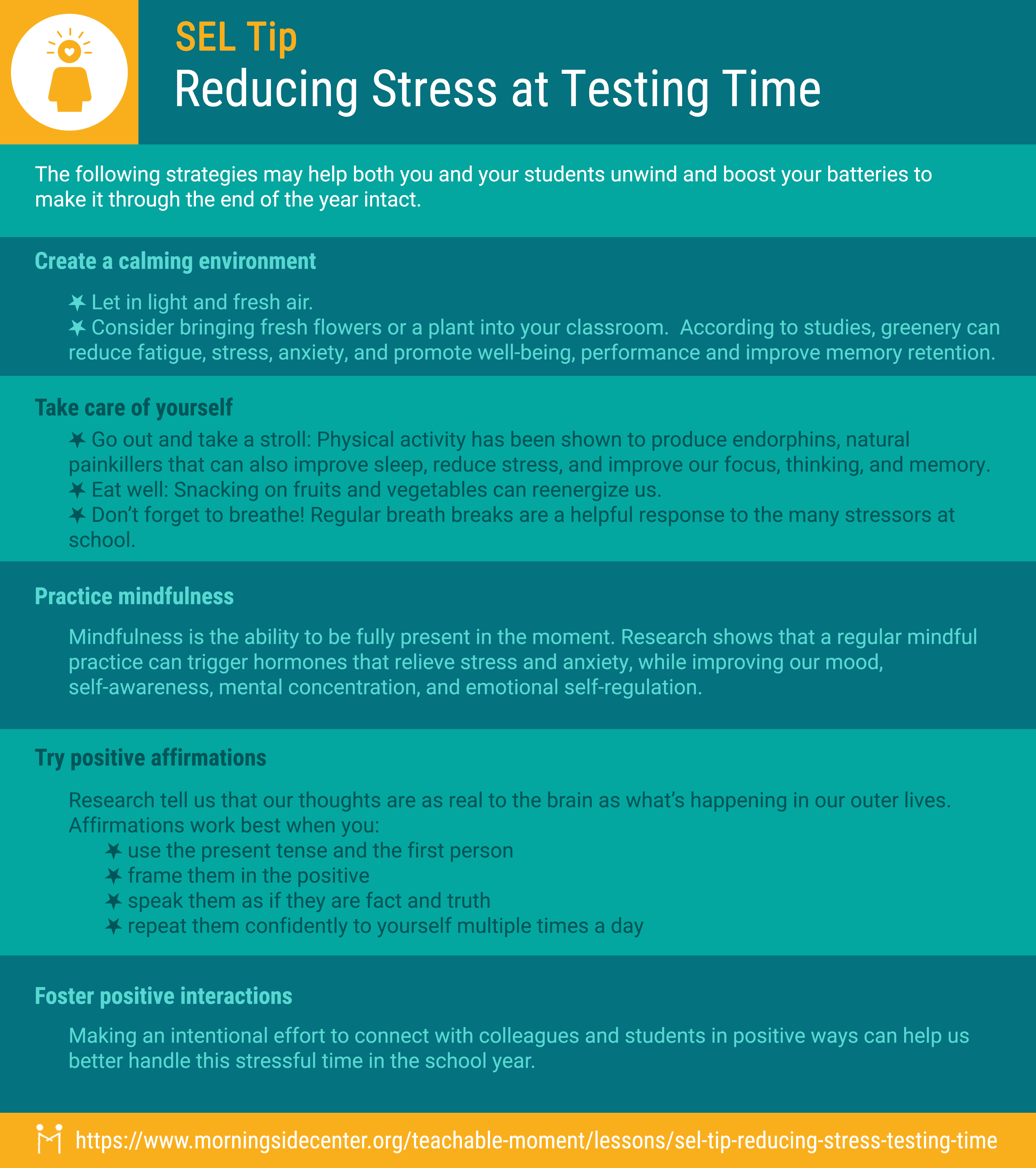As May and June roll around, we educators are in the homestretch. Summer is just around the corner. And yet it’s also testing season, which doesn’t allow us to unwind, just yet.
The pressure is on, and stress is everywhere. Not just the moderate amounts of stress that can push our students to be more focused, pay attention, and perform better, but also the overwhelming and debilitating stress provoked by high stakes testing in particular. And we know stress is contagious. What’s more, many educators have their own worries about test results and are already running on empty at this time of year. It’s an unhealthy mix.
The following strategies may help both you and your students unwind and boost your batteries to make it through the end of the year intact.
Create a calming environment
- Let in light and air. Open the shades and flood your classroom with light. Consider cracking open those windows to let in some fresh air as well.
- Get some greenery. Consider bringing fresh flowers or a plant into your classroom. According to studies, greenery can reduce fatigue, stress, anxiety, and promote well-being, performance and improve memory retention. In addition, caring for a plant can be a perfect project for a student who seems disconnected or detached. It can teach responsibility and gives students an added incentive to come to class.
Take care of yourself
- Go out and take a stroll: Being outdoors, especially in green areas, can help reduce stress and increase overall well-being. And physical activity has been shown to produce endorphins, natural painkillers that can also improve sleep, reduce stress, and improve our focus, thinking, and memory.
- Eat well: Faculty rooms at this time of year can be full of donuts, cookies, pizza and other unhealthy “comfort” foods left over from school events. These foods can make us feel lethargic. Snacking on fruits and vegetables can reenergize us instead.
- Don’t forget to breathe! Take a beat, take a few deep breaths, especially as you walk into a stressful space or situation. Deep breathing can counteract the body’s stress response. Regular breath breaks are a helpful response to the many stressors at school.
Practice mindfulness
Consider practicing mindful awareness with your students throughout the year, so that you have a buffer when testing and other stressful times come around. Mindfulness is the ability to be fully present in the moment. Research shows that a regular mindful practice can trigger hormones that relieve stress and anxiety, while improving our mood, self-awareness, mental concentration, and emotional self-regulation. A few minutes of mindful breathing meditation (or practices such as yoga and tai chi), several times a week, can make a noticeable difference, especially during stressful times.
Try positive affirmations
As we slow down, breathe deeply, relax, and become more aware of our thoughts and feelings, we can also learn to take charge of our thoughts in ways that can help us improve our performance. Research tell us that our thoughts are as real to the brain as what’s happening in our outer lives. This is one reason why positive affirmations can be so effective. Affirmations work best when you:
- use the present tense and the first person (as in, “I am calm now”)
- frame them in the positive (instead of “I’m not going to fail this time,” try “I’ve got this”)
- speak them as if they are fact and truth (no mights, shoulds, or coulds)
- repeat them confidently to yourself multiple times a day, especially before going to sleep or right before a test
You can reinforce positive affirmations with physical touch. Tap the back of your hand, gently caress your arm or apply pressure to your temples as you state your affirmation. Consider positive affirmations that have four syllables (e.g. “I can do this,” “I am ready,” “I am calm now,” etc.) so that you can squeeze your thumb and fingers together one syllable at a time, from your index finger, through your pinky, several times over.
Foster positive interactions
Finally, we can help reduce stress by engaging in positive interactions and encouraging them between students. Experts recommend a ratio of five positive interactions to counteract each negative interaction, because negative emotions tend to involve more thinking than positive emotions, and invite rumination. Making an intentional effort to connect with colleagues and students in positive ways can help us better handle this stressful time in the school year.
And if this list of strategies for reducing stress is stressing you out, pick just one idea that you feel drawn to and commit to practicing it in the weeks ahead. See how it makes you feel.
